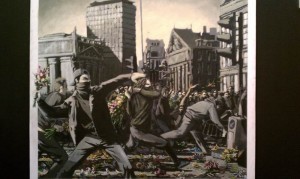Graffiti art taking over MOCA Geffen
Graffiti scrawled on overpasses, in alleys and on the fronts of apartment buildings can be seen as a nuisance that promotes gang activity and lowers property value.
But the Art in the Streets exhibit at the Los Angeles Museum of Contemporary Art presents graffiti in a different light through commissioned and voluntary works.
Art in the Streets is the first major exhibition of graffiti to be organized by an American museum.
The exhibit at MOCA has garnered both harsh criticism for glorifying this illegal act and praise for its acknowledgement of graffiti as a form of self-expression.
The elaborately tagged school bus in front of the entrance of the exhibit is just a small taste of what the show has to offer.
Upon entering the exhibit, the first pieces serve as an overview of notable graffiti styles that developed throughout the years in different parts of the world, starting in the early 1970s.
The exhibit puts emphasizes techniques that originated in Los Angeles and New York City, highlighting their contrasting styles. The colorful “wild style” of the East Coast is complemented with tags from hip-hop culture, while gritty “cholo” graffiti exists alongside the Southern California punk and skate scene graffiti.
After this introduction to the graffiti art world, the rest of the exhibit is a massive network of elaborate backdrops that takes hours to fully experience.
Banksy, one of the most recognizable names in the graffiti world, has his own tribute section that is significantly larger than most of the other exhibit sections. A striking mural of a young man kneeling to pray under massive, tagged archways catches the eye immediately.
There are plenty of other Banksy works, featuring mostly dark shades with minimal splashes of bright colors, that show off his trademark style.
The most compelling section of Art in the Streets puts visitors right in the middle of the action, as they walk through a display set up to feel like an actual city street while seeing works by artists such as Todd James, Dan Murphy and Alexis Rose.
The details in the dark and dirty alley are phenomenal, from tagged payphones to vibrant block-letter advertisements and marked-up liquor store windows.
A look into several bedrooms, most of them small and made up of three walls, on this faux city street gives insight into what the private life of a graffiti artist is like, with rough sketches scattered on a desk and spray cans hidden under a bed.
After maneuvering through the buzzing “street,” there are dozens of smaller rooms to look through that are dedicated to individual street artists.
Standout displays include work from Retna, an Angeleno whose bright blue symbols cover the walls, making his display dynamic and distinctive. Next door, you can view professional skateboarder Mark Gonzales’ take on street art characterized by long, distorted mirrors covered with engaging phrases in simple black lettering.
The display by Neckface is also remarkable, setting up a strikingly realistic New York subway atmosphere in which there is trash on the floor, scribblings on the cold walls and a mannequin of a hobo sleeping in a dark corner.
One argument in defense of graffiti art is its ability to present critical political and social commentary not found in other art forms. At Art in the Streets, however, there are very few examples of this politically charged variety on display.
Any message that seemed too loaded, including renowned Italian street artist Blu’s piece featuring dollar bills on top of caskets, was removed before the exhibit’s opening by head curator Jeffrey Deitch, according to The Huffington Post.
Thankfully, there is so much to see that the lack of controversial statements doesn’t take much impact away from of Art in the Streets.
Short films and documentaries are played in theater rooms and projected on walls throughout the museum.
There is also a cozy reading room toward the end of the exhibit and a small skate ramp serving as a reminder that graffiti can go hand-in-hand with other trends and lifestyles.
The bathrooms, too, are exhibits of their own, with bold bubbled letters covering each stall door.
At times overwhelming in its scope of displays, Art in the Streets is a unique showcase likely to attract the youth of the Los Angeles area.
MOCA is taking a bold leap by treating graffiti as a legitimate art form. But no matter your opinion on it, it’s hard to deny this exhibits entertainment value and mass appeal.
Art in the Streets runs until Aug. 8 at the Geffen Contemporary of the Museum of Contemporary Art. The museum is located at 152 North Central Ave. in Los Angeles


Comments are closed.